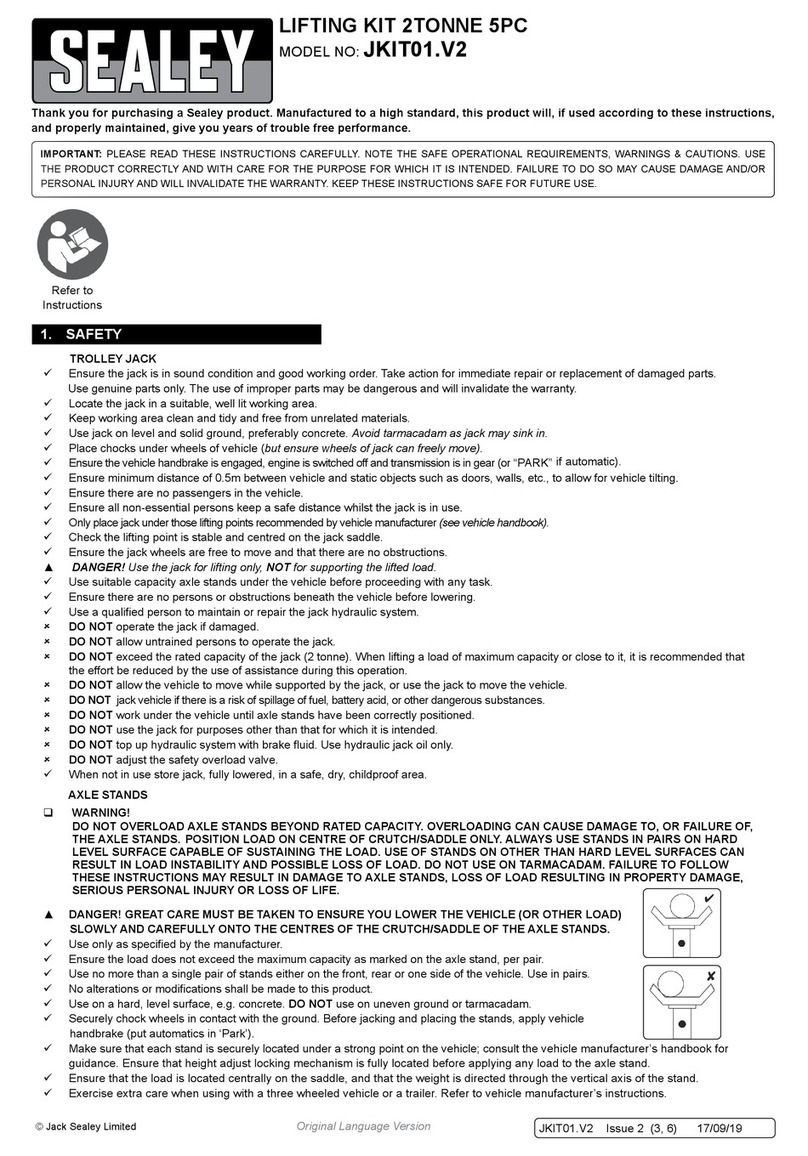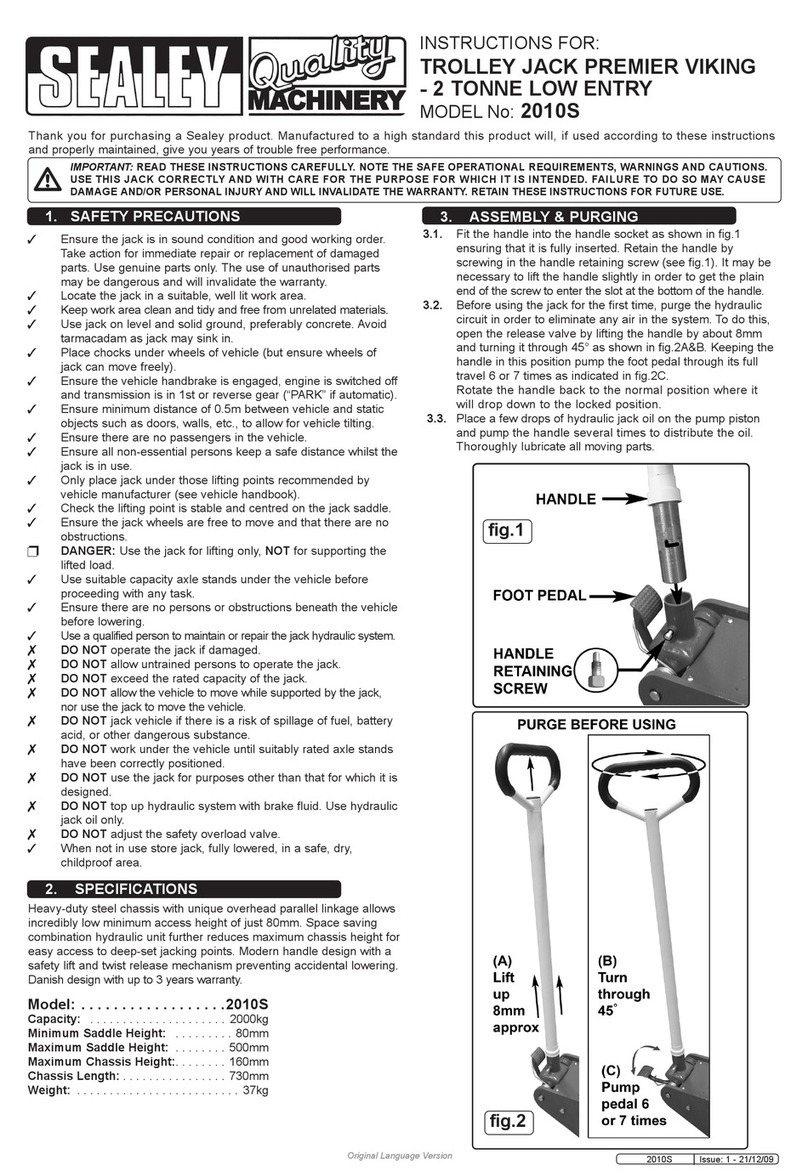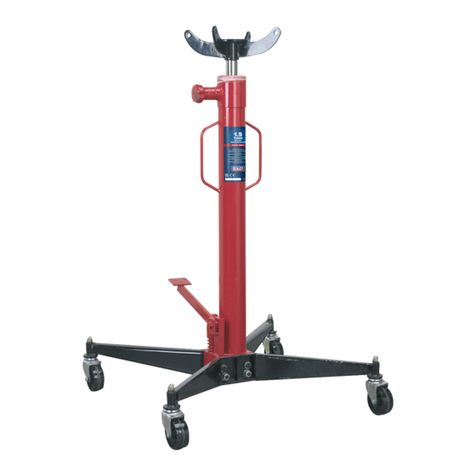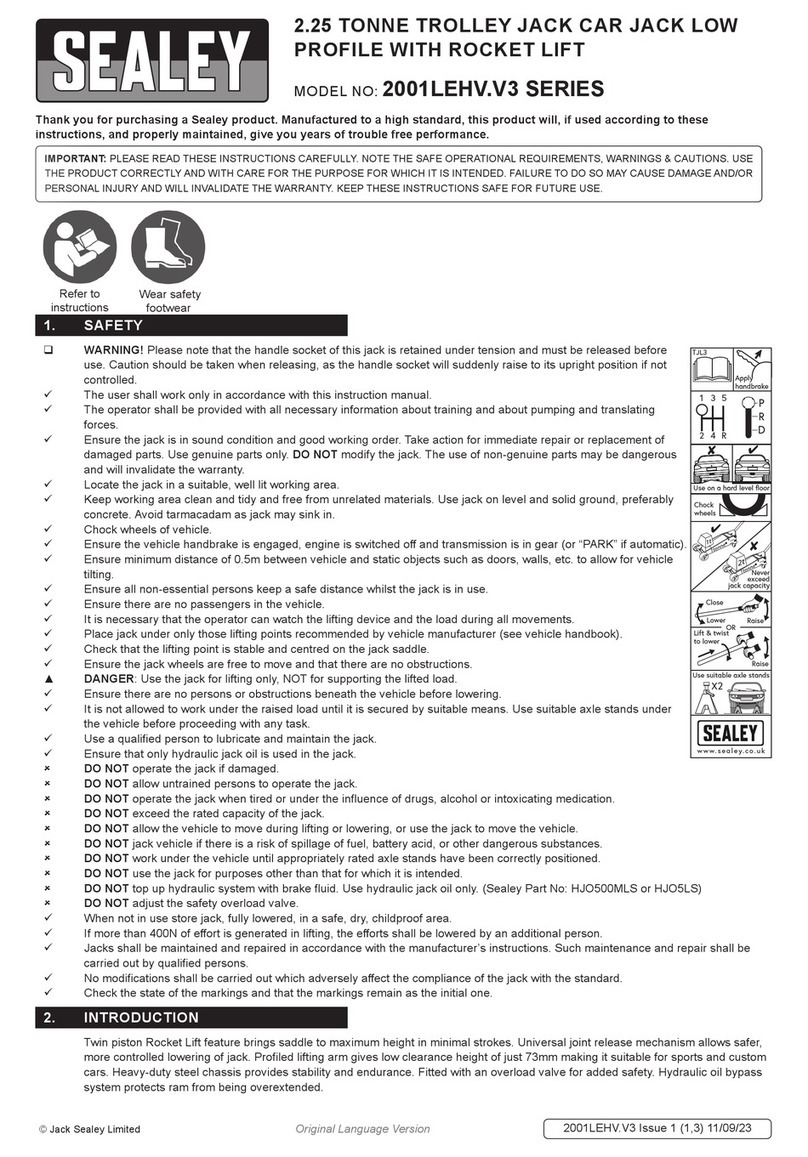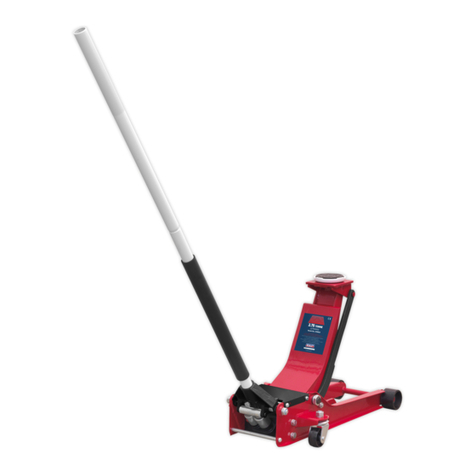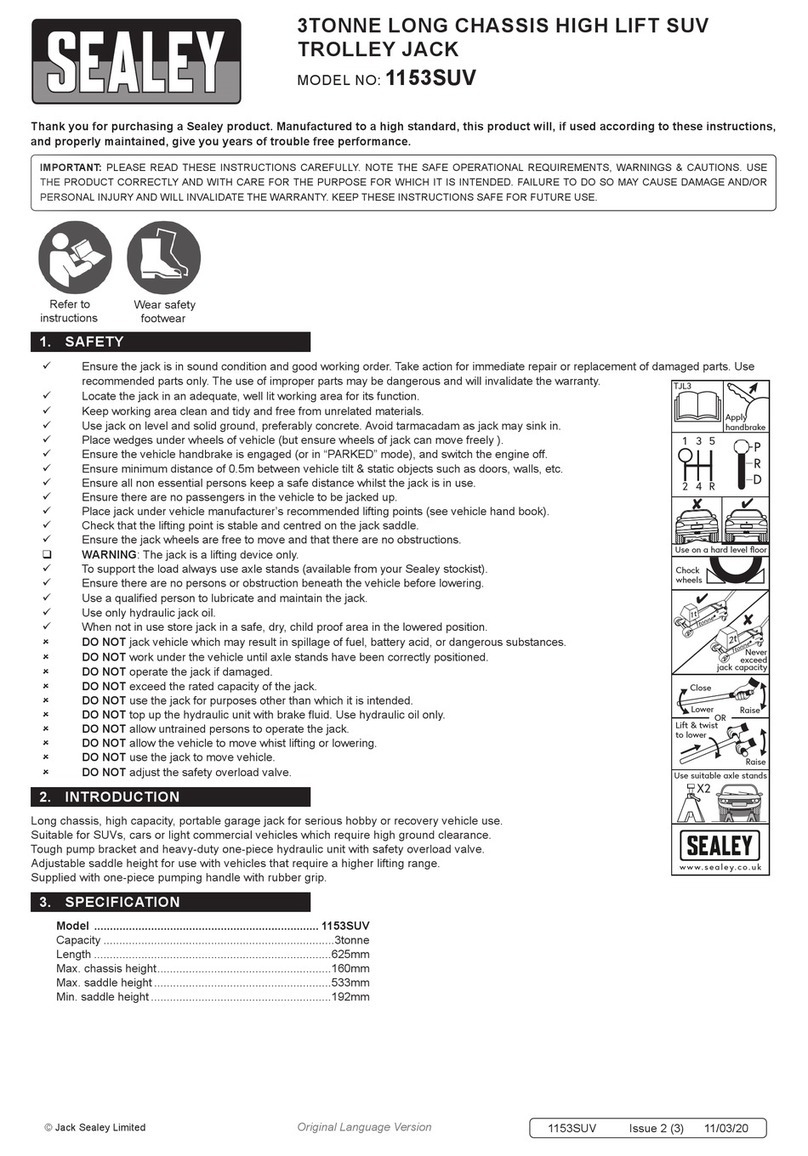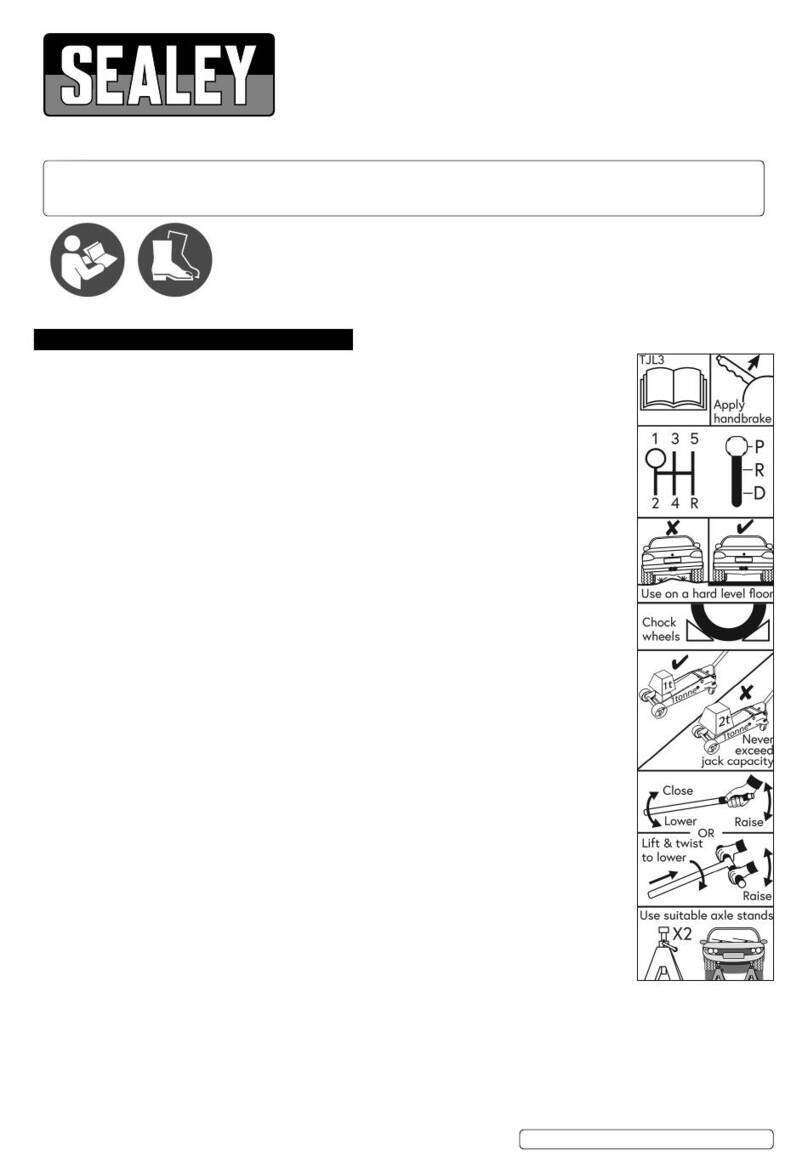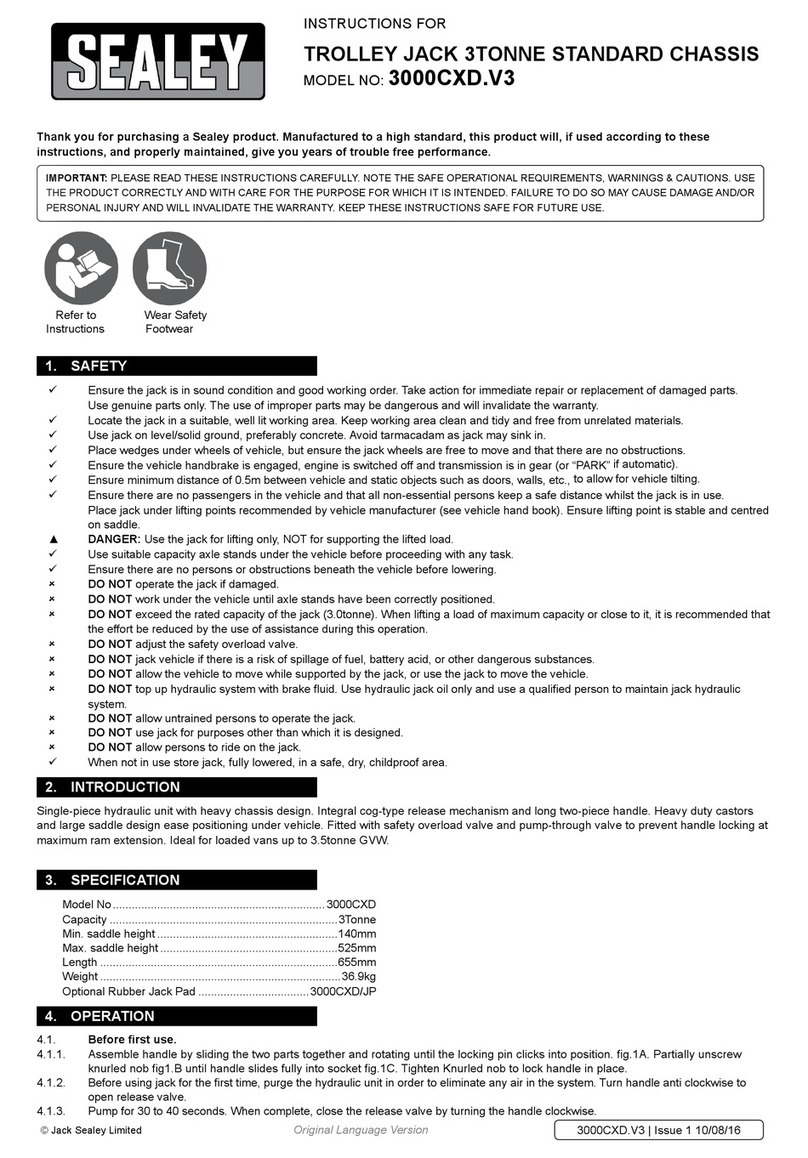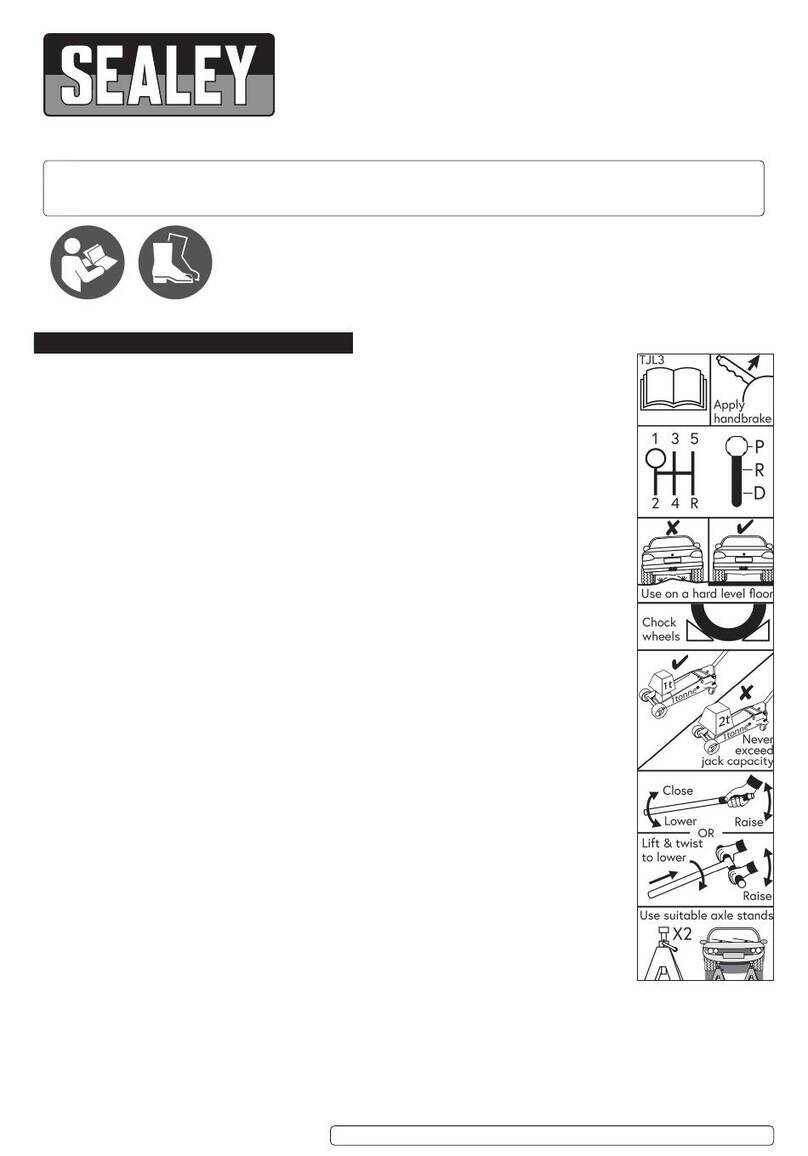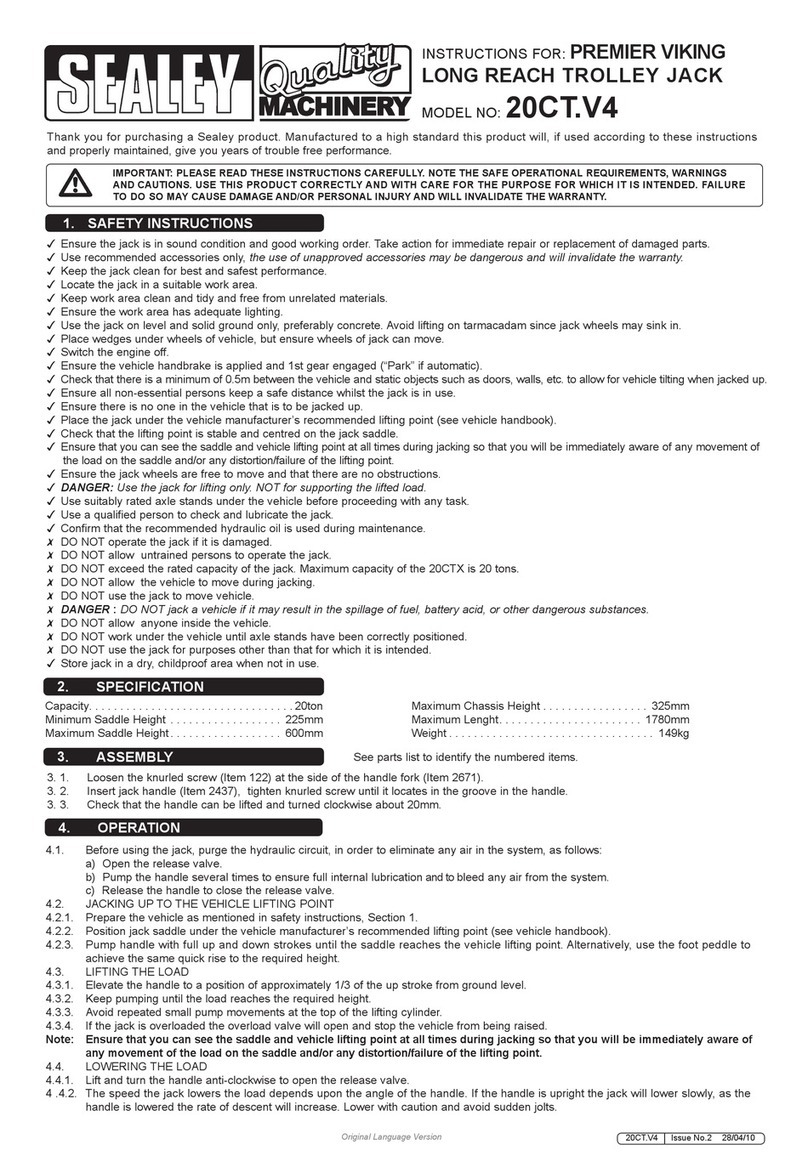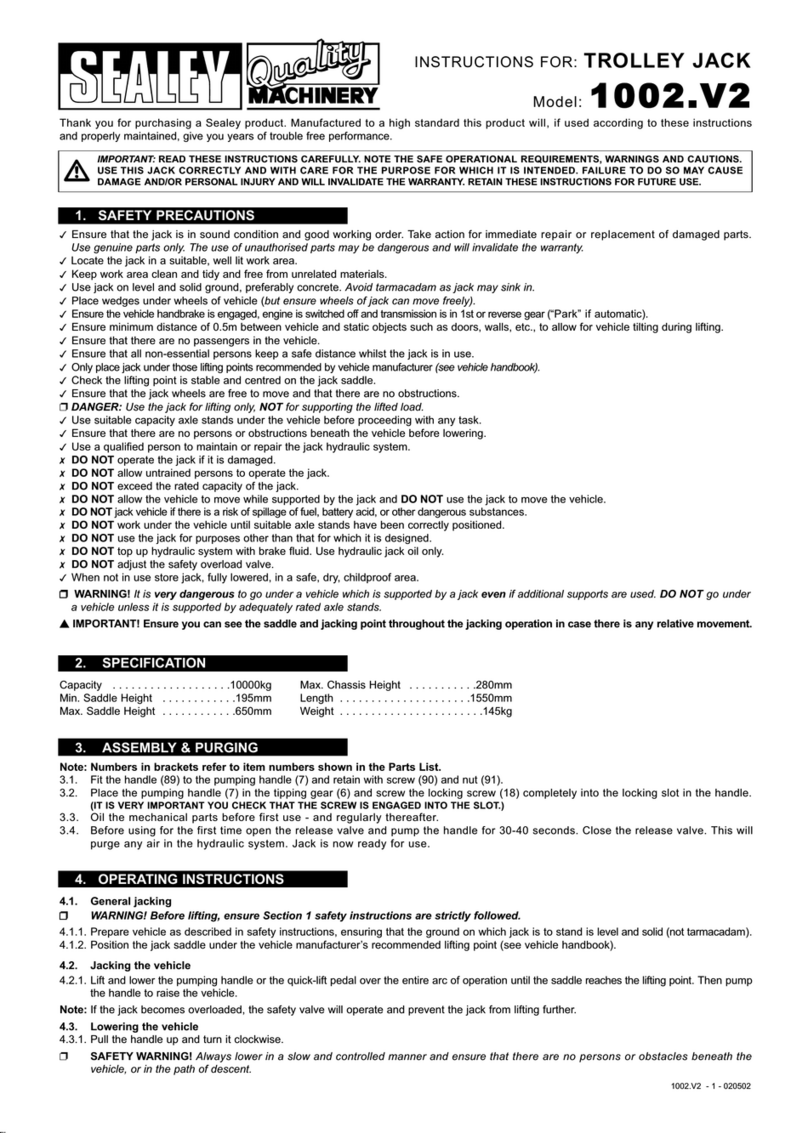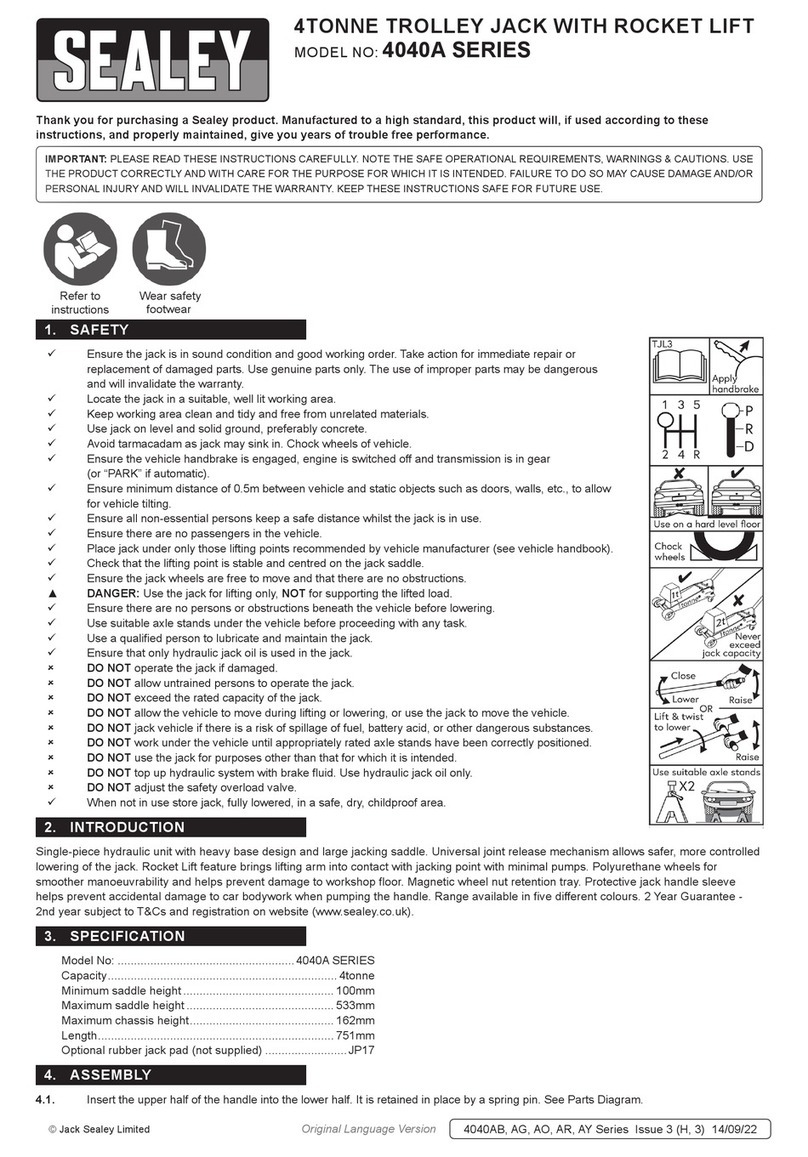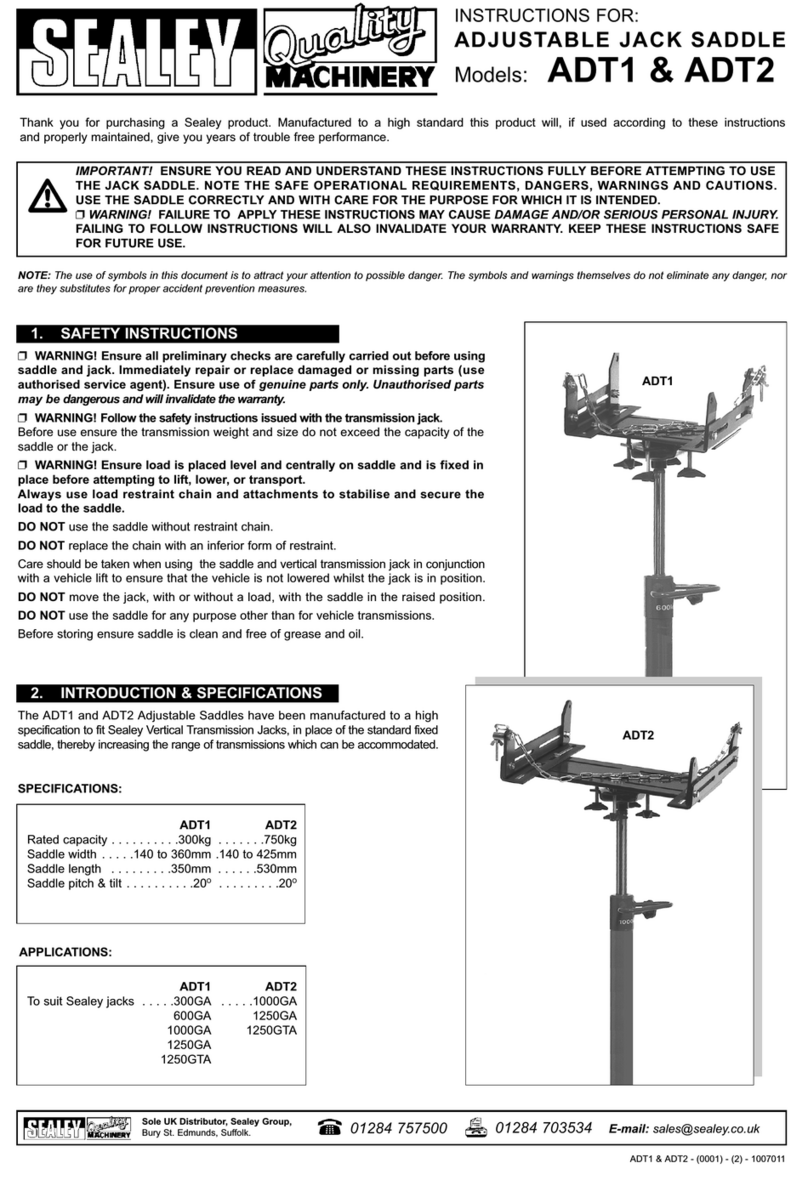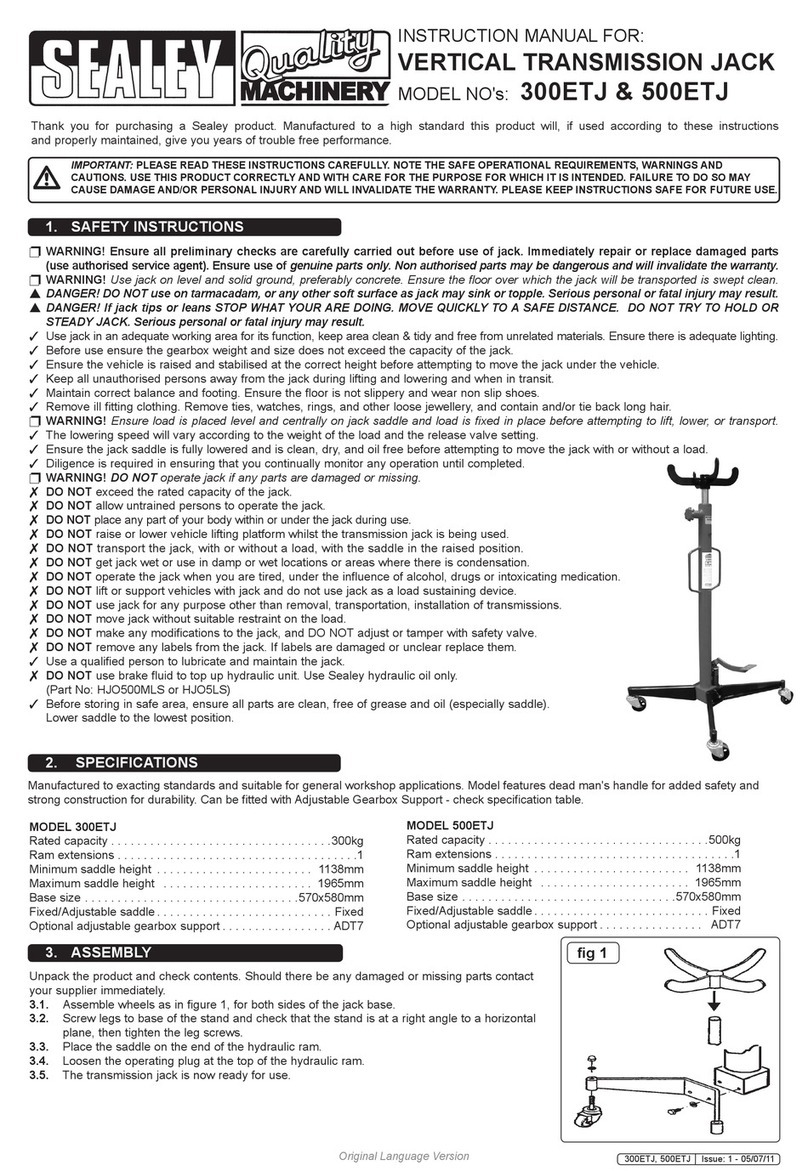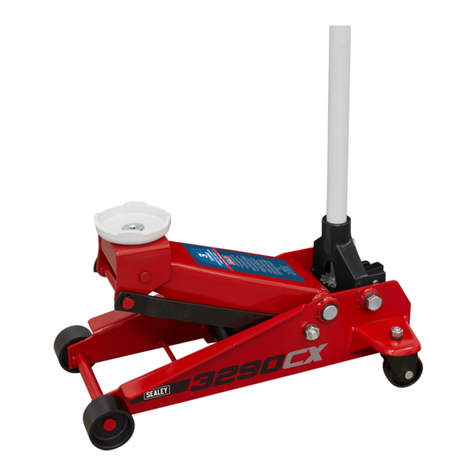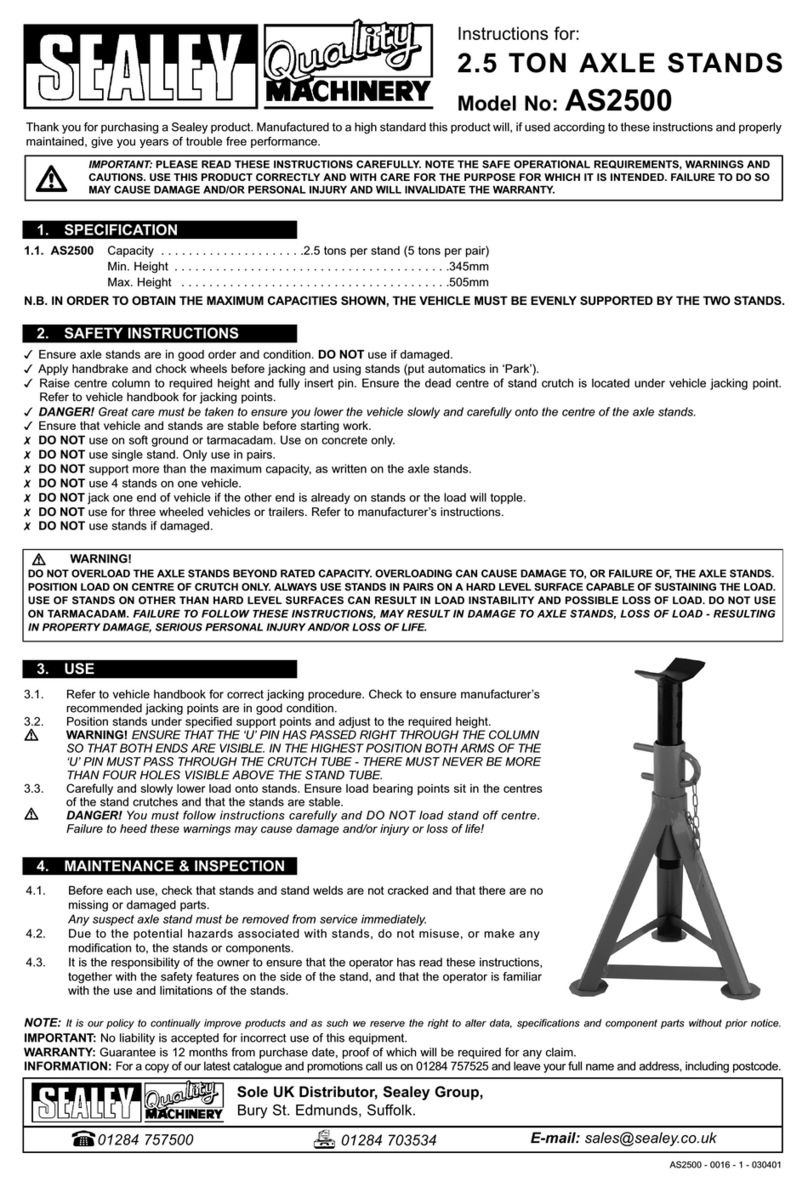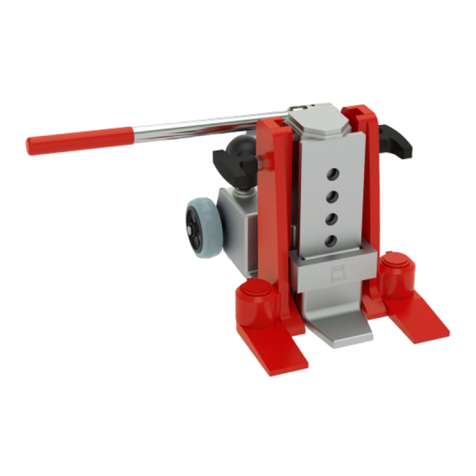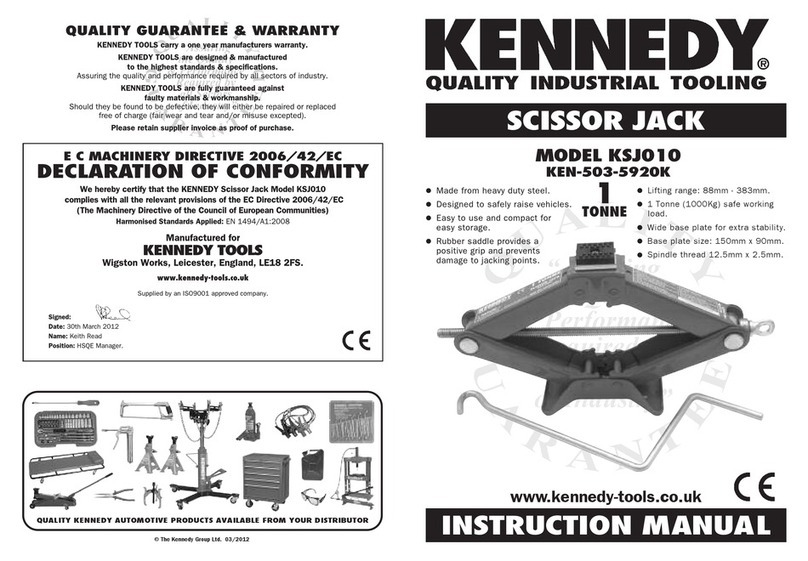
6. OPERATION - AXLE STANDS
6.1. Refer to manufacturer’s instructions for recommended jacking/support points. Check to ensure jacking/support points are in good
condition.
6.2. Position the stands beneath the manufacturer’s recommended support points.
6.3. To adjust the stands: Hold the control lever up while lifting the centre column to required height. Push the control lever down to lock
the pawl into the central column teeth (fig.2 and fig.3).
WARNING! ENSURE PAWL IS FULLY ENGAGED WITH TEETH.
6.4. Lower vehicle onto stands carefully and slowly. Ensure load bearing points sit in the centre of the saddles and that the stands are stable.
Also ensure that there are no objects or persons that could impede the safe lowering of the vehicle onto the stands.
▲DANGER! You must follow these instructions carefully and ensure you DO NOT load the stands off centre. Failure to adhere to these
warnings may cause damage, injury or loss of life!
7. MAINTENANCE - JACK
7.1. When the jack is not in use, the ram and the handle socket should be in their lowest positions to minimise corrosion.
Remove the handle to deactivate the jack.
7.2. Keep the jack clean and lubricate all moving parts on a regular basis.
7.3. Before each use, check for broken, cracked, bent, or loose parts, or any visible damage to ram, pump, saddle, lifting arm, frame and
all parts including nuts, bolts, pins and other fasteners. If any suspect item is found remove jack from service and take necessary
action to remedy the problem.
8DO NOT use the jack if believed to have been subjected to abnormal load or shock load.
7.4. Periodically check the pump piston and piston rod for signs of corrosion. Clean exposed areas with a clean oiled cloth.
7.5. After one year the oil should be replaced in order to extend the life of the jack. Use hydraulic jack oil only.
7.6. IMPORTANT: Only fully qualified personnel should attempt hydraulic maintenance or repair.
7.7. To check the hydraulic oil level, fully lower the jack and the handle and remove the tray covering the oil filler plug (fig.5), remove the oil
filler plug (fig.5). The correct oil level should be approximately 5mm below the filler opening. If oil level is low, fill as required. Make sure
that dirt is not allowed to enter the hydraulic system. Carefully pump unloaded jack 5 or 6 times to expel any air and then refit oil filler plug.
NOTE: Use a good quality hydraulic jack oil, such as SEALEY HYDRAULIC JACK OIL.
WARNING: DO NOT use brake fluid, or any fluid other than hydraulic jack oil, as this may cause serious damage to the jack and will
invalidate the warranty!
IMPORTANT: NO RESPONSIBILITY IS ACCEPTED FOR INCORRECT USE OF THE JACK.
Hydraulic products are only repaired by local service agents. We have service/repair agents in all parts of the UK. DO NOT RETURN
JACKS TO US. Please telephone 01284 757500 to obtain address and ‘phone number of your local agent. If Jack is under
guarantee please contact your dealer.
7.8. DE-COMMISSIONING THE JACK.
7.9. Should the jack become completely unserviceable and require disposal, draw off the oil into an approved container and dispose of the
jack and the oil according to local regulations.
8. MAINTENANCE - AXLE STANDS
8.1. Before each use, check that stands and stand welds are not cracked and that there are no missing or damaged parts.
8.2. Any suspect axle stands must be removed from service immediately.
8.3. Due to the potential hazards associated with stands, DO NOT misuse, or make any modification to, the stands or components.
8.4. It is the responsibility of the owner to ensure that the operator has read these instructions together with the safety features on the side
of the stand and that the operator is aware of the stand uses and limitations.
9. TROUBLESHOOTING - JACK
PROBLEM POSSIBLE CAUSE REMEDY
Jack will not lift
the load
Jack does not lift
high enough or
feels “spongy”
Jack lifts poorly
Jack lifts but will
not hold load
Jack will not lower
completely
Jack does not
lower at all
1) Be sure to use jack with adequate capacity
2) Top up oil level
3) Check and close release valve
4) Open release valve and pump the handle a few times. Close valve and re-try
5) Clean and replace oil
6) Replace packing
1) Top up oil level or remove excess oil
2) Return jack to local service agent
3) Open release valve and pump the handle a few times. Close valve and re-try
4) Check and close release valve
1) Replace packing and/or clean valves
2) Replace oil
3) Open release valve and pump the handle a few times. Close valve and re-try
1) Check and close release valve
2) Lower jack, close release valve. Place foot on front wheel and pull up lifting arm to it's full height by hand
Open the release valve to lower arm
3) Open release valve and pump the handle a few times. Close valve and re-try
4) Replace packing or contact local service agent
5) Replace packing
1) Oil all external moving parts
2) Replace rod or contact local service agent
3) Replace damaged parts or contact local service agent
4) Open release valve and pump the handle a few times. Close valve and re-try
5) Check and fully open release valve
6) Replace spring or contact local service agent
1) Check and fully open release valve
1) Overloaded
2) Oil level low
3) Release valve not correctly closed
4) Air in system
5) Piston rod not functioning
6) Packing worn or defective
1) Oil level too high or too low
2) Worn seals
3) Air in system
4) Release valve not closed
1) Pump packing or valves malfunctioning
2) Oil is dirty
3) Air in the system
1) Release valve partially open
2) Dirt on valve seats
3) Air in system
4) Faulty seals
5) Packing worn or defective
1) Unit requires lubrication
2) Piston rod bent or damaged
3) Jack frame/link system distorted due
to overloading/poor positioning
4) Air in system
5) Release valve partially open
6) Jack spring damaged
1) Release valve still closed
3015CXHV | Issue 2 (3) 07/02/19
Original Language Version
© Jack Sealey Limited


